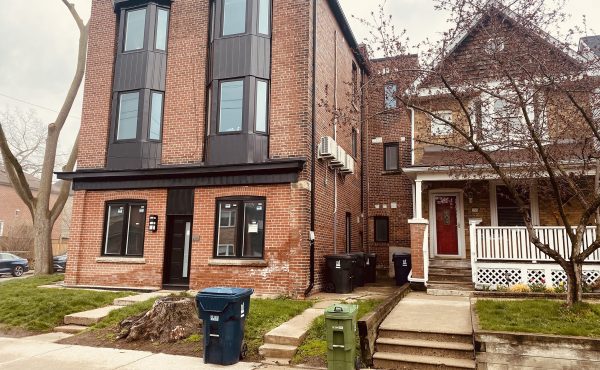Since the City announced chief planner Jennifer Keesmaat’s departure last week, much of the commentary about her stint in that high profile gig has focused on negatives: how she wasn’t able to block the Scarborough subway extension (as per the deep-dive reporting by my colleague Jennifer Pagliaro); her failure to halt the reconstruction of the Gardiner Expressway; and how she seems to not be running for high public office, or at least not yet.
Many people, moreover, associate Keesmaat with a vaguely daring sort of star power and her relentless public advocacy of the sorts of progressive planning policies that have, in recent years, become the coin of the realm in that profession.
But the real capstone of Keesmaat’s tenure is a far more technical and sprawling project that aims to do nothing less than give the city the capacity to bring some sanity and proactive planning to the raging speculative fever that has gripped the downtown for over a decade.
After a two-year-long planning and consultation process, TOCore, a.k.a. the new downtown secondary plan, lands on the agenda of council’s planning and growth management committee this Thursday.
I have no inside information, but it seems to me that it’s not an accident that Keesmaat’s decision to move on coincides with the culmination of an extensive analytical process that encompasses numerous sub-plans, new investment strategies, public outreach sessions, private stakeholder meetings and all the other elements that went into the making of this particular sausage.
As Paul Bedford’s planning legacies were the Avenues and the Kings, Keesmaat’s will be TOCore. So it’s worth delving into the substance of this enormously complex document to look for clues as to whether the moves contained therein will address the growth challenges confronting a core area defined by runaway land prices and dramatically over-taxed infrastructure.
Bedford sought to enable development, and his somewhat laissez faire approach was rooted in a pragmatic response to the double-whammy of the early 1990s, when the city experienced an exodus of traditional manufacturing and a real estate collapse, both of which threatened the downtown’s livability and economic stability. With the Kings, he sought to legitimatize alternative uses for aging brick-and-beam warehouses that had been illegally colonized by artists and small tech firms.
His “three lenses” approach to urban regeneration, which pre-dates amalgamation, signaled commercial developers that the City was willing to cut deals on fallow industrial lands (e.g., the Stockyards) if that meant re-investment (e.g., with big-box malls). That framework also established the assumption that stable neighbourhoods (lens one) were sacrosanct from a planning and redevelopment perspective.
Finally, Bedford’s notion of offering as-of-right approvals to developers willing to erect mid-rise/mixed-use projects on suburban arterials also spoke to a planning stance that aimed to take the fetters off builders, but do so within the context of a European-inflected vision of transit-oriented (re-)development.
When she took office a generation later, Keesmaat had to confront the mixed legacies of those policies. The Kings planning reforms proved to be far more attractive to builders than anyone had ever imagined, and the interest by developers was greatly amplified by the provincial Places to Grow Act.
Meanwhile, the unprecedented surge of residential real estate prices, driven by all sorts of factors (historically low interest rates, downtown destinations, etc.) has produced the ring-fencing/gentrification dynamic that increasingly dominates local planning debates, and which reached a surreal nadir with the Atwood/Weston broadside against a mild-mannered mid-rise on Davenport.
But the redevelopment of both fallow industrial lands and the suburban arterials has progressed much more haltingly, also for a range of reasons, not least of which was the gold-rush mentality that seized downtown developers and condo investors, and has caused capital to pool massively in parts of the core.
How, then, does a chief planner serving a suburban-dominated council make a case for more orderly downtown development in an attempt to avoid killing the goose that laid the golden egg?
Keesmaat’s Downtown Secondary Plan, to my eye, aims to walk this precarious tightrope, although it will be interesting to see how much of it survives the inevitable shiv attacks at the Ontario Municipal Board and the equally inevitable political nitpicking on the policy elements, particularly those involving money.
While neither Keesmaat nor Mayor John Tory would ever say so out loud, the plan sends a crystal clear signal to the development industry that the anything-goes era is over.
Builders will no longer be able to buy their way out of statutory obligations, such as parkland dedications, and they’ll have to pay attention to the broader impacts of their projects – everything from shadows to the way they contribute (or not) to the communities where they land.
To that end, the plan calls for more generous set-backs, prescriptive requirements for affordable and family-sized apartments, and the submission of “complete community assessments” to “to ensure all developments contribute to the creation of liveable and complete communities.” The previous as-of-right planning rhetoric has yielded to more dirigiste concepts such as “defining scales of growth.”
The document further signals builders that they simply can’t gobble up everything in their path, with previously announced measures, for example, to protect the historical warehouse district and certain types of local cultural and live music venues – both elements of the downtown built form that, paradoxically, attracted billions in re-investment but are now mortally threatened by the same.
Keesmaat’s audience, however, isn’t just the building industry. The proposed plan directly challenges council, and especially its suburban majority, to approve the necessary infrastructure, transit and public realm improvements required to allow an incredibly fast-growing part of the city to function properly – e.g., more protected bike lanes, priority for transit vehicles, significant investments in parks.
Again, some of these changes pre-date the completion of TOCore – e.g., the city’s stated intention to create rail deck park, the approval of a somewhat watered down pilot of the King streetcar and real progress on the planning of the relief line — and have secured council approval, in principle.
But in defiance of stern warnings from city manager Peter Wallace, Tory and council earlier this year refused to approve new tax measures that might have helped underwrite some of the infrastructure investment required to deal with the downtown’s various growth pressures. (Given Doug Ford’s likely presence in next year’s mayoral race, it seems exceedingly unlikely that Tory will dare to touch this issue again anytime soon.)
And while Keesmaat’s plan makes the right noises about affordable housing, responsibility for that intractable issue rests with the upper orders, and their willingness to ante up the necessary funding, tax and monetary incentives. Nonetheless, it is worth noting that Keesmaat’s downtown plan is mostly silent on identifying strategies for promoting purpose-built multi-unit residential projects, which have become increasingly popular with institutional investors looking for stable, revenue-producing assets.
All of which brings me back to Keesmaat’s approach to this business of being the chief planner.
With the possible exception of the medical officer of health, no other civil servant has the same kind of latitude to do his or her work as publicly as the chief planner. Which, of course, is as it should be: planning the city is about way more than the technical minutiae of land use designations and zoning.
Keesmaat was certainly a highly public chief planner, as visible and media friendly as Bedford (likewise an outspoken figure who took a lot of crap from the public) yet savvy in the ways of social media.
Under her watch, the planning department radically shifted its thinking about public engagement, e.g., with the intensive focus-group-like consultations used in developing TOCore. But her broader goal, clearly, was to direct Toronto’s unruly civic conversation towards a highly pressing question: how an enormously successful city avoids collapsing beneath the weight of its own success.
In that light, Keesmaat’s advocacy of biking and pedestrian-friendly streets and transit and the like spoke to challenge of forcing diverse stakeholders and citizens to begin differentiating between a dense but vibrant city and a merely over-crowded one.
Her public pronouncements and pose evoked, as the Ryerson City Buidling Institute’s Cherise Burda notes, New York City’s crusading transportation planning czar Janette Sadik-Khan, another hard-driving and outspoken woman operating in a traditionally male domain.
The difference, as Burda points out, is that former New York City mayor Michael Bloomberg gave Sadik-Khan all sorts of political cover to advance historic changes, whereas Keesmaat, an equally ambitious figure, had to constantly adjust her program to suit a parochial council and a hyper-cautious mayor who sometimes seems to be afraid of his own shadow.
Yet what’s less recognized is that Keesmaat was also addressing herself directly — and often contentiously — to Toronto’s powerful private development industry, telegraphing its members that they must start thinking more about the city and less about merely moving units as quickly as possible.
That, to me, is what the Downtown Secondary plan, and Keesmaat, is saying with this long-awaited document: that obtaining a public license to build in this concentrated zone we call downtown Toronto is no longer going to be such a gimme. The terms of engagement have got to be about much more than just swapping a dozen extra floors for some public art and a playground with all the trimmings.
In the obscure world of monetary policy, there’s a knowing old joke that the job of the central banker is to take away the punch bowl just when the party gets going. Keesmaat found herself facing a somewhat similar bureaucratic condundrum — the official tasked with telling a bunch of moneyed and well-connected revelers to take it down a notch.
Within the claustrophobic confines in which Toronto planning policy is formulated, she likely pushed that argument about as far as any civil servant could have. Her legacy, the Downtown Secondary Plan, now passes into the hands of the politicians, who absolutely should endorse TOCore’s prescriptions as a way of paying it forward to the future residents of mid-century Toronto.
Needless to say, no one should be especially optimistic about that particular outcome. But it’s certainly fair to say that Jennifer Keesmaat — in the past six years but especially the last three — seized every opportunity to persuade them to do the right thing.






3 comments
A serious loss for Toronto. I predict bigger and better things for her and certainly not in politics!
Thanks for this detailed overview of Kessmaat’s tenure as planning chief. Isn’t the crucial question facing housing policy in Toronto captured in this paragraph:
“Meanwhile, the unprecedented surge of residential real estate prices, driven by all sorts of factors (historically low interest rates, downtown destinations, etc.) has produced the ring-fencing/gentrification dynamic that increasingly dominates local planning debates, and which reached a surreal nadir with the Atwood/Weston broadside against a mild-mannered mid-rise on Davenport.”
That is, is the downtown going to be nothing but a playground for Canada (and the world’s) wealthiest people? Are Toronto city planners and politicians content to see all middle-class (and even upper middle-class) people simply priced out of the market? Are we going to go directly the way of San Francisco, London, and New York?
This has created real and painful class divisions that erupted in the Micallef/Atwood twitter affair. If I may, I have written an analysis of why that particular exchange is so important for understanding the current state of class politics in Toronto:
https://thefourteenthfloor.com/2017/09/05/margaret-atwood-and-the-lessons-of-materialism/
Until city planners get serious about reducing the cost of housing in the city, class divisions are only going to widen, with dangerous polarization across demographic and cultural divides following.
The biggest problem with the TOcore plan, and one that marks it as a failure, is its unwillingness to touch the sacrosanct “stable neighbourhoods.” Just another excuse for rich legacy land owners to keep out new entrants. There’s no policy goal met by preserving that zoning, just nimby political pressure.